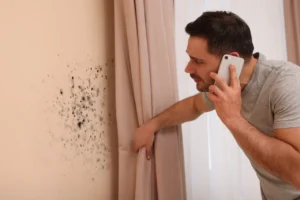15 Things That Will Always Fail a Home Inspection (And How to Get Them Fixed)
 Waiting for home inspection results can be nerve-wracking—for both the seller and the buyer. But knowing what parts of a home will fail the test can help alleviate some stress and shock. No home is perfect, and few inspections will earn an A+. Whether you’re buying or selling a home, read through our list of the 15 most common things that cause a home to fail inspection and what you can do to fix them.
Waiting for home inspection results can be nerve-wracking—for both the seller and the buyer. But knowing what parts of a home will fail the test can help alleviate some stress and shock. No home is perfect, and few inspections will earn an A+. Whether you’re buying or selling a home, read through our list of the 15 most common things that cause a home to fail inspection and what you can do to fix them.
1. Roofing Issues
A home inspector will climb your roof, looking for missing, curling, or crumbling shingles. Depending on its condition, or your roof is over 20 years old, your inspector might suggest you budget for a new roof, which can cost $25,000 on average to replace.
Potential fix: Have a licensed roofing professional perform regular inspections and replace any damaged shingles, as well as make any other necessary repairs.
2. Weakening Foundation
Signs that you might have a foundation issue include doors that stick, large cracks in the walls, and horizontal cracks in the exterior foundation (this is especially common in homes built over soil with clay in it). Tree roots, improperly constructed second-stories, or natural disasters such as earthquakes can also produce cracks in a foundation.
Fix: Address foundation issues immediately to avoid a domino effect of other problems. Consult with a structural engineer to assess any damage and create a repair plan.
3. Rodent or Insect Infestations
No one wants to buy a home, only to deal with hordes of unwelcome guests. Termites, mice, raccoons, and rats can cause all sorts of structural damage (beyond just being gross). Don’t worry; if there’s evidence of foul play, your inspection will note it.
Fix: Call a pest control company to check for signs of pest infestations and regularly treat your home as a proactive measure.
4. Low Water Pressure
An inspector will turn on every plumbing fixture one by one to check the water pressure. If it’s low, they’ll hunt for low-diameter piping, a clogged aerator, or corroded pipes. Did you know your water pressure can also be too high? They’ll mark homes for that, too.
Fix: Hire a local plumber to diagnose the problem and make any necessary repairs.
5. Decaying Attic Insulation
Your home inspector will confirm that your home has the recommended insulation level in the attic, usually between 10 and 14 inches. They will also record any other areas where the insulation is in poor condition.
Fix: Check the health and level of your insulation and get it replaced if necessary.
6. Bad Windows
Assume that your home inspector will open and close every window to check for signs of damage, drafts, condensation, and the overall condition of the panes and frame.
Fix: If problems are present, hire a window contractor to repair any obvious damage, add more insulation, or install new ones.

7. Electrical Issues
When it comes to electrical systems, ungrounded receptacles, exposed light bulbs, double-tapped circuit breakers, and malfunctioning GFCI outlets are all issues a home inspector must note on their report.
Fix: Upgrade your receptacles to three-prong outlets, cover all exposed lightbulbs, and make sure outdoor receptacles have bubble covers. Hire an electrician if you suspect there are deeper wiring problems to address.
8. Poor Drainage
Problems with the surface grading around your home could cause drainage problems and even foundation damage. In addition, surface grading issues can lead to basement leaks, causing mildew and mold. Ideally, your lawn should have a 3% slope away from your home. If not, your inspector will disclose it.
Fix: Use topsoil to create an appropriate slope around your house; the ground should drop two to three inches for every 10 feet you move away from the foundation. Also, check your gutters and downspouts for clogs and signs of deterioration.
9. Failing Heating System
An aging furnace is a definite red flag for potential buyers. Your inspector will remove the cover of your furnace or heat pump to look for signs of age, mold, and general signs of disregard. They’ll also check for blocked chimneys, damaged heat exchangers, any malfunctioning controls, or exhaust flues that aren’t up to code.
Fix: Hire an air duct cleaning company to thoroughly clean your HVAC and surrounding parts, and make sure to perform general maintenance regularly. If your HVAC is older than 15 years old, consider replacing it.
10. Rotted Wood
Rotted wood can hide in window sills and under your decking. Your home inspector will use an awl to probe untreated wood and see if any rot is present.
Fix: Examine the corners of windows and doors. If necessary, have a contractor remove the rotted wood and replace it with fresh wood.
11. Interior Leaks or Signs of Moisture
f your inspector notices stains on the walls or ceilings, they will dig deeper into the home’s plumbing to pinpoint a high moisture level, which can indicate a leak. Even if they do not find a troublesome amount of moisture, they might recommend having a professional take a closer look at the leaks.
Fix: Hire a plumber to check for any leaking that could signify larger issues elsewhere. Once repaired, paint over any stains for a fresh new look.
12. Signs of Mold 
Signs of leakage also indicate a potential mold issue. Your inspector will use moisture meters or an infrared camera to detect excessive moisture and use their eyes and nose (yes, mold smells) to locate troublesome spots.
Fix: Address any leaks quickly, repair your home’s surface grading, and maintain appropriate humidity levels in your home. If mold is present, get it removed and treated by a professional as soon as possible.
13. Building Code Violations
It’s important that all prior home renovations were done to code. Your inspector may not know all the building codes by heart, but they will look for signs the construction was done improperly, such as handrails that don’t turn and stop at a wall, bathroom exhaust fans that don’t vent outside, or missing deck flashing.
Fix: Have a building inspector review any renovations according to codes in your area, and if needed, provide recommended steps for repair.
14. Malfunctioning Safety Features
The inspector will ensure all safety features such as door locks and carbon monoxide and smoke detectors function properly.
Fix: Replace the locks on windows and doors, replace the batteries in your smoke and carbon monoxide detectors, and review local laws and building codes to ensure you have the number of sensors required for the size of the home.
15. Harmful and/or Outdated Building Materials
Asbestos is present in many homes built before 1981 in insulation, vinyl flooring, or spray-on surfacing materials. Crumbling insulation in an older home can indicate asbestos. Homes built before 1978 may also have lead paint. While most home inspections do not include a lead paint test, you can add it for a fee. Finally, carbon monoxide and radon can leak into your home via broken appliances or foundation cracks; your inspector will likely use a specialty detector to look for high gas levels.
Fix: Depending on your home’s age, have a professional examine your home for harmful materials and suggest a remediation plan if needed.
Our Home Inspection Failed—Now What?
If your home inspection was, um…a real eye-opener, consult your real estate agent for advice. They’ll comb over the report details and consider the current market when formulating an action plan.
As a buyer, you have options including:
-
Ask the seller to make repairs
-
Ask the seller for a credit (consult with contractors first to determine an appropriate amount that will cover the repairs)
-
Submit a lower counteroffer
-
Move on to other homes if the repairs feel like they are too much to take on
As a seller, you have options including:
-
Fix the repairs
-
Offer sellers a repair credit
-
Sell the home “as is,” although this may require lowering the purchase price of the home
-
Purchase a one-year home warranty for your buyer, which can cover repairs to HVAC systems, appliances, and some electrical work
Keep in mind that if a seller decides not to make repairs and the buyer backs out, the seller must disclose the findings when they put the home on the market again.
Source: Angi













 Accessibility
Accessibility